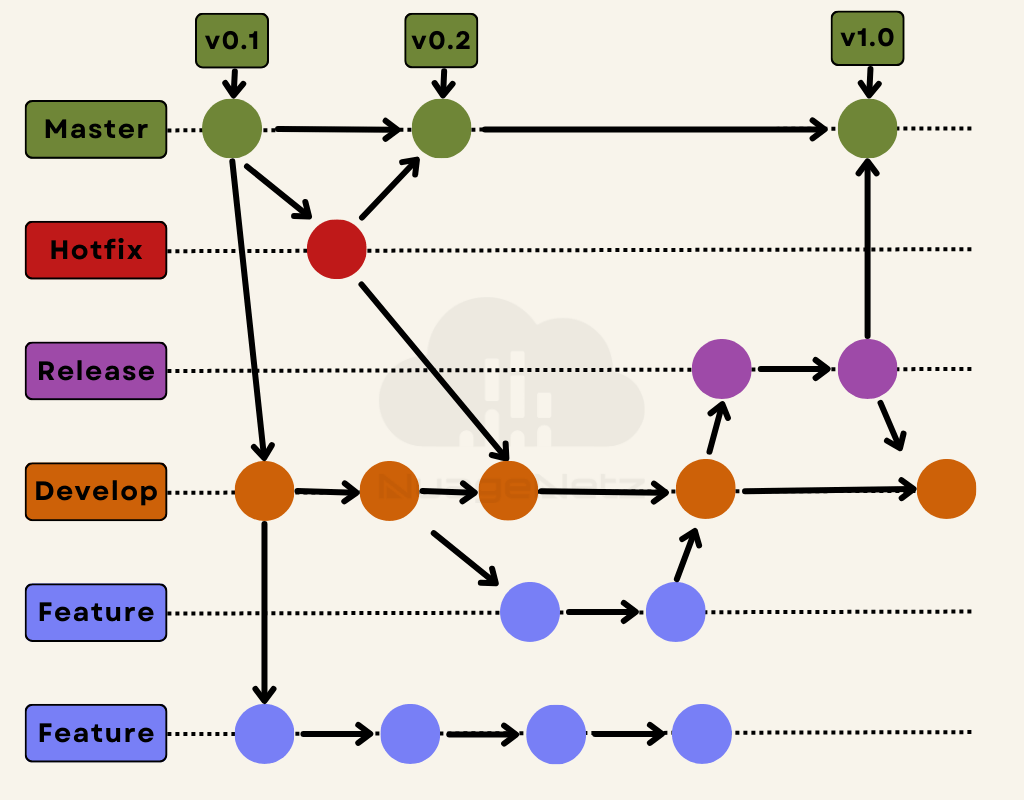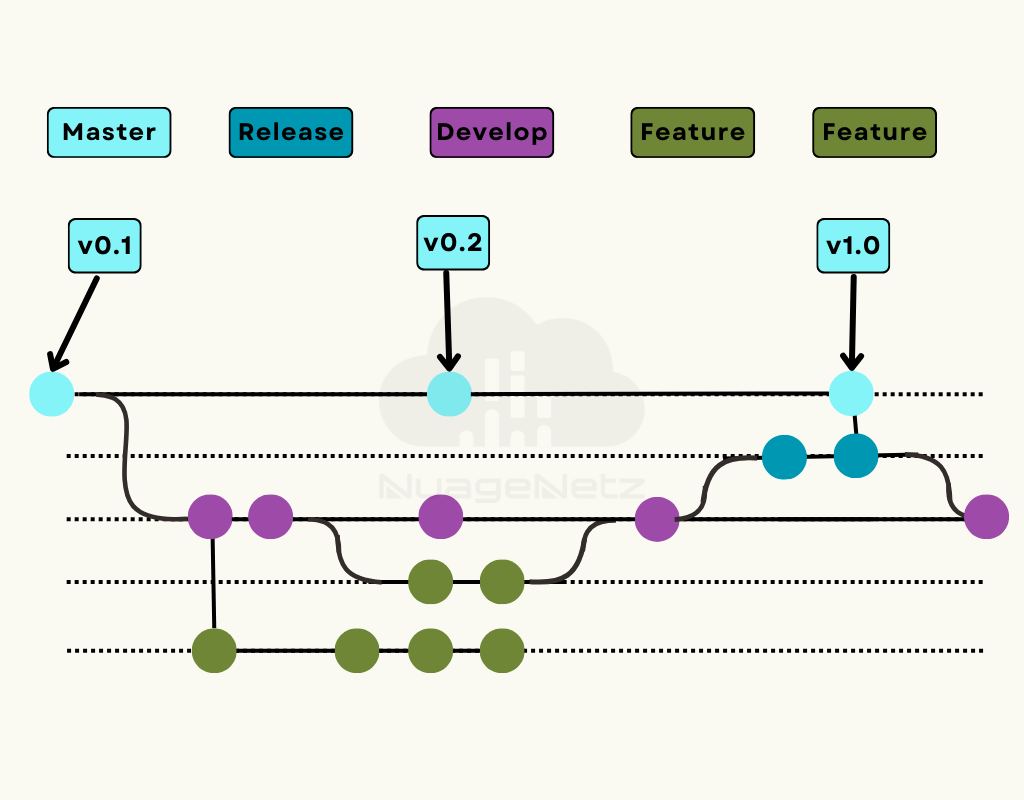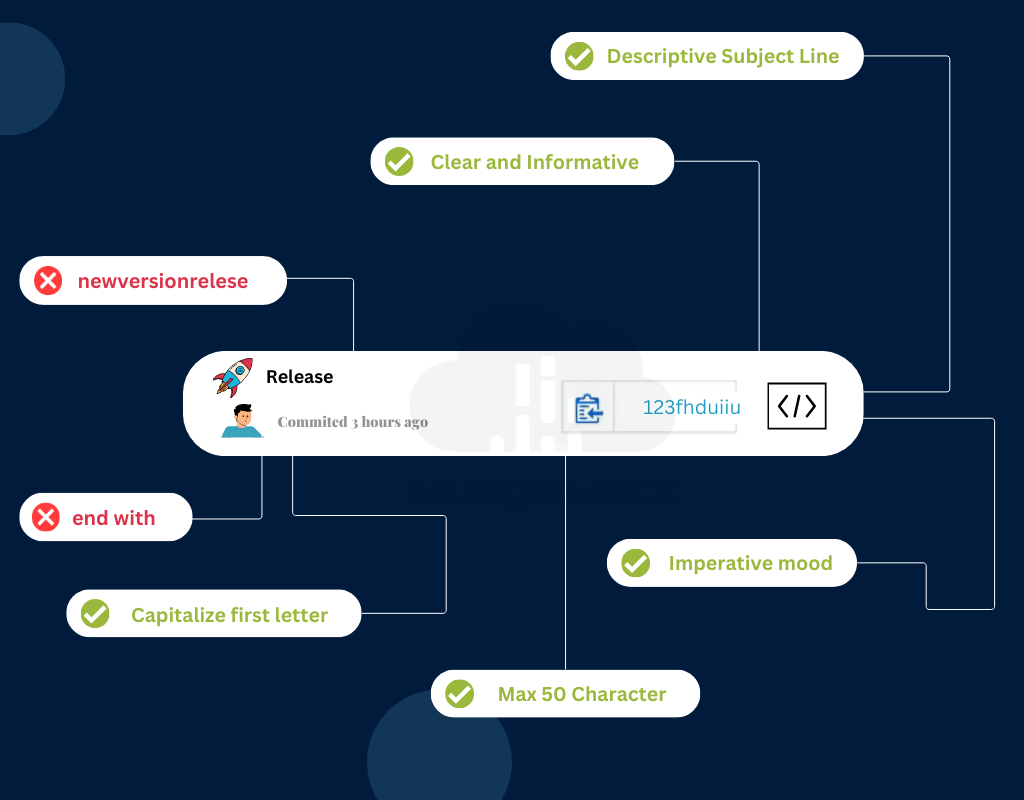Let’s dive into some tips and strategies to help you maximize the benefits of Git in your projects.

Git Uses:
- Initializing a Repository: To start using Git, you first initialize a repository in your project directory using the ‘git init’ command. This creates a hidden ‘.git’ directory where Git stores metadata and the repository’s history.
- Adding Files: After initializing a repository, you can add files to it using the ‘git add’ command. This adds the files to the staging area, preparing them to be committed to the repository.
- Committing Changes: Once files are added to the staging area, you commit them to the repository using the ‘git commit’ command. Each commit represents a snapshot of the project’s state at a particular point in time, along with a commit message describing the changes made.
- Branching: Git allows for branching, enabling parallel development of different features or fixes. You can create a new branch using ‘git branch <branch-name>’ and switch to it using ‘git checkout <branch-name>’ or combine both actions with ‘git checkout -b <branch-name>’. The main branch is typically named master or main.
- Merging: Once work on a branch is complete, changes can be merged back into the main branch using the ‘git merge’ command. This combines the changes from one branch into another, integrating the branch’s history into the main branch.
- Remote Repositories: Git facilitates collaboration by allowing repositories to be hosted remotely on platforms like GitHub, GitLab, or Bitbucket. You can push your local changes to a remote repository using ‘git push’ and pull changes from a remote repository using ‘git pull’.
- Reviewing History: Git provides various commands to review the project’s history, including git log to view commit history, git diff to see changes between commits or branches, and git blame to see who last modified each line of a file.
Git Providers
When it comes to hosting your code repositories using Git, there are several popular Git hosting platforms that cater to different needs and preferences. Here are some of the leading Git providers in the industry:
- GitHub
- GitLab
- Bitbucket
- AWS CodeCommit
- SourceForge
GitHub:

GitHub is one of the most popular Git repository hosting services that offers a wide range of collaboration tools for developers. It provides a user-friendly interface, issue tracking, pull requests, and integration with various third-party tools. GitHub is widely used in open-source projects and by individual developers to showcase their work.
GitLab:

GitLab is a complete DevOps platform built on top of Git repositories. It offers features for not only version control but also continuous integration, deployment, and monitoring. GitLab comes with a free open-source community edition as well as a paid enterprise edition with additional features for larger organizations.
Bitbucket:

Bitbucket is a Git repository management solution from Atlassian that provides tools for code collaboration, project management, and continuous delivery. It offers both Git and Mercurial repositories, along with features like pull requests, pipelines, and code insights. Bitbucket is popular among teams using other Atlassian products like Jira and Confluence.
AWS CodeCommit:

AWS CodeCommit, provided by Amazon Web Services (AWS), is a fully managed Git hosting service offering secure and scalable repository hosting in the cloud. It seamlessly integrates with other AWS services such as CodePipeline and CodeBuild for building and deploying applications. AWS CodeCommit offers pay-as-you-go pricing based on usage, with free tier options for new AWS customers.
SourceForge:

SourceForge is an open-source software development platform offering Git hosting alongside project management tools, forums, and a community-driven marketplace. With a long history, it hosts a vast number of open-source projects across various domains. SourceForge provides free Git repository hosting for open-source projects and offers additional services for commercial projects.
Git Branch Naming Strategies:
Effective branch naming strategies are essential for maintaining clarity, organization, and collaboration within a Git repository. Here are some commonly used and recommended Git branch naming strategies:


Master Branch:
The ‘master’ branch typically represents the stable, production-ready version of your codebase. It should contain only fully tested and approved code.
Direct commits to the ‘master’ branch are often restricted, and changes are usually merged into it via pull requests after thorough code review and testing.
Feature Branches:
Feature branches are created to develop new features or functionalities independently of the ‘master’ branch.
Each feature branch should have a clear purpose and scope, focusing on implementing a specific feature or addressing a particular issue.
Once development is complete, the feature branch is merged back into the ‘master’ branch via a pull request.
Release Branches:
Release branches are used to prepare for a new release or version of your software.
They allow for stabilization, bug fixes, and final testing before deploying the new version.
- Once the release is ready, the changes from the release branch are merged into both ‘master’ and ‘develop’ branches.
Hotfix Branches:
Hotfix branches are created to address critical issues or bugs in the production environment.
These branches are based directly on the ‘master’ branch to ensure that fixes can be deployed quickly without interfering with ongoing development in other branches.
After the hotfix is applied and tested, changes are merged into both master and develop branches to maintain consistency.
Development Branch:
The ‘develop’ branch serves as the main integration branch for ongoing development work.
It contains the latest changes and serves as a basis for creating feature branches.
Regular integration of feature branches into ‘develop’ ensures continuous integration and keeps the codebase up-to-date.
Experimental Branches:
Experimental branches are used for exploring new ideas, implementing experimental features, or conducting research.
They provide a sandbox environment for developers to work on without affecting the stability of other branches.
Experimental changes can be merged into relevant branches if they prove successful and align with project goals.
how to write good commit message?

Writing good commit messages is essential for maintaining a clear and informative history of changes in a Git repository. Here are some tips to help you write effective commit messages:
- Be Descriptive: Provide a clear and concise description of the changes introduced by the commit. Describe what the commit does and why it’s necessary. Avoid vague or ambiguous language.
- Use the Imperative Mood: Start the subject line with an imperative verb (e.g., “Add”, “Fix”, “Update”, “Remove”) to indicate what the commit accomplishes. This makes the message more actionable and consistent with Git’s built-in commands.
- Keep it Short: Limit the subject line to around 50 characters to ensure it’s concise and easy to scan. Use the body of the commit message to provide additional context and details if needed.
- Separate Subject and Body: Leave a blank line between the subject line and the body of the commit message. Use the body to provide more detailed information about the changes, including the rationale behind them and any relevant considerations.
- Wrap Lines Properly: When writing the body of the commit message, wrap lines at around 72 characters to maintain readability. This ensures that the message is easy to view in terminal-based tools and Git clients.
- Use Present Tense: Write commit messages in the present tense to describe what the changes do when applied. For example, “Fix a bug” instead of “Fixed a bug”.
- Reference Related Issues: If the commit addresses a specific issue or task tracked in a project management system (e.g., JIRA, GitHub issues), reference it in the commit message. Use keywords like “Fixes”, “Closes”, or “Resolves” followed by the issue or task number to automatically link the commit to the corresponding issue.
- Follow a Consistent Format: Establish a consistent commit message format within your team or project to ensure clarity and uniformity. Consider using a conventional format like the Conventional Commit format for more structured and standardized messages.
- Review Before Committing: Take a moment to review your commit message before finalizing it. Ensure that it accurately reflects the changes made and provides sufficient context for others to understand the commit’s purpose.
- Be Professional: Maintain professionalism in your commit messages, even in informal projects. Clear and well-written messages contribute to a positive collaborative environment and make it easier for others to work with your code.
Conclusion
In conclusion, developing a solid understanding of Git branch naming strategies and commit message formats is crucial for maintaining a well-organized and efficient version control workflow. By following best practices, adopting advanced Git workflows, and promoting collaboration within your team, you can streamline your development process and improve overall productivity. Remember, Git is a powerful tool, and mastering its best practices will set you on the path to success in your software development projects.
We hope you found this blog post helpful and informative. Stay tuned for more tips and insights on Git and software development in our future posts! If you have any questions or suggestions, feel free to reach out in the comments section below. Happy coding with Git!
About Us
NuageNetz IT Services Pvt. Ltd. is a cutting-edge IT company that specializes in Cloud Computing, Web Development, DevOps and Agile Methodologies. Our team of skilled professionals is dedicated to providing exceptional services to our clients using the latest technologies and tools
Got Something to say about our Blog?
Have something to say? Drop your thoughts, feedback, or questions in the comments below!
